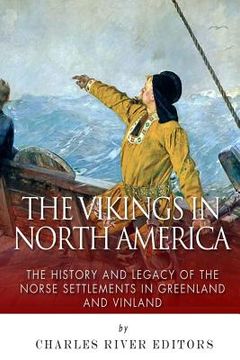The Vikings in North America: The History and Legacy of the Norse Settlements in Greenland and Vinland (en Inglés)
Reseña del libro "The Vikings in North America: The History and Legacy of the Norse Settlements in Greenland and Vinland (en Inglés)"
*Includes pictures *Includes accounts of the Vikings' expeditions from medieval sagas *Includes a bibliography for further reading *Includes a table of contents Over the centuries, the West has become fascinated by the Vikings, one of the most mysterious and interesting European civilizations. In addition to being perceived as a remarkably unique culture among its European counterparts, what's known and not known about the Vikings' accomplishments has added an intriguing aura to the historical narrative. Were they fierce and fearsome warriors? Were they the first Europeans to visit North America? It seems some of the legends are true, and some are just that, legend. The ubiquitous picture of the Vikings as horn-helmeted, brutish, hairy giants that mercilessly marauded among the settlements of Northern Europe is based on a smattering of fact combined with an abundance of prejudicial historical writing by those who were on the receiving end of Viking depredations. At the same time, much of the popular picture of the Vikings is a result of the romantic imagination of novelists and artists. However, the Vikings' reputation for ferocious seaborne attacks along the coasts of Northern Europe is no exaggeration. It is true that the Norsemen, who traded extensively throughout Europe, often increased the profits obtained from their nautical ventures through plunder, acquiring precious metals and slaves. Of course, the Vikings were not the only ones participating in this kind of income generation; between the 8th and the 11th centuries, European tribes, clans, kingdoms and monastic communities were quite adept at fighting with each other for the purpose of obtaining booty. The Vikings were simply more consistently successful than their contemporaries and thus became suitable symbols for the iniquity of the times. Of course, the military reputation came about because the Vikings were the great mariners and explorers of medieval Europe. While many of their journeys were ones of conquest, they also had a deep love of exploration, and from their homeland in Scandinavia, they traveled as far as North America and became the first Europeans who are known to have set foot on what is now Canada. It was not until 1960 that the actual site of a Viking settlement in Vinland was found. At the tip of the Great Northern Peninsula in Newfoundland, Canada, a small Viking settlement at L'Anse aux Meadows was excavated, with the foundations of three residential halls have been found. These halls would have housed between 70 and 90 people. As well as the sod covered halls, a smithy where nails were made and a small boat repair building have been found. It is believed that this settlement, which may have had as many as 500 inhabitants, is one of two settlements called Straumfjord and Hóp mentioned in the Saga of Erik the Red as being his Vinland bases. L'Anse aux Meadows is thought to be the former, and it is believed that Hóp was a summer camp perhaps as far south as New Brunswick. The native inhabitants of the New World were called Skrellings by the Vikings, and there is evidence that they engaged in battle with the Beothuks at L'Anse aux Meadows and the Mi'kmaq people further south. While there is still debate over where exactly the Norse settled the land, there is no hard evidence that they ventured further south than Newfoundland, where remains of a settlement have been found. If they had rounded Cape Breton and crossed the Cabot Strait, they would have come to a markedly different environment that would probably have compelled the explorers to come up with a fourth name for the region south of Vinland. The Vikings in North America chronicles the historic voyages the Vikings made to North America and what's known and unknown about their pre-Columbian settlements. Along with pictures of important people, places, and events, you will learn about the Norse colonization of North America like never before, in no time at all.

